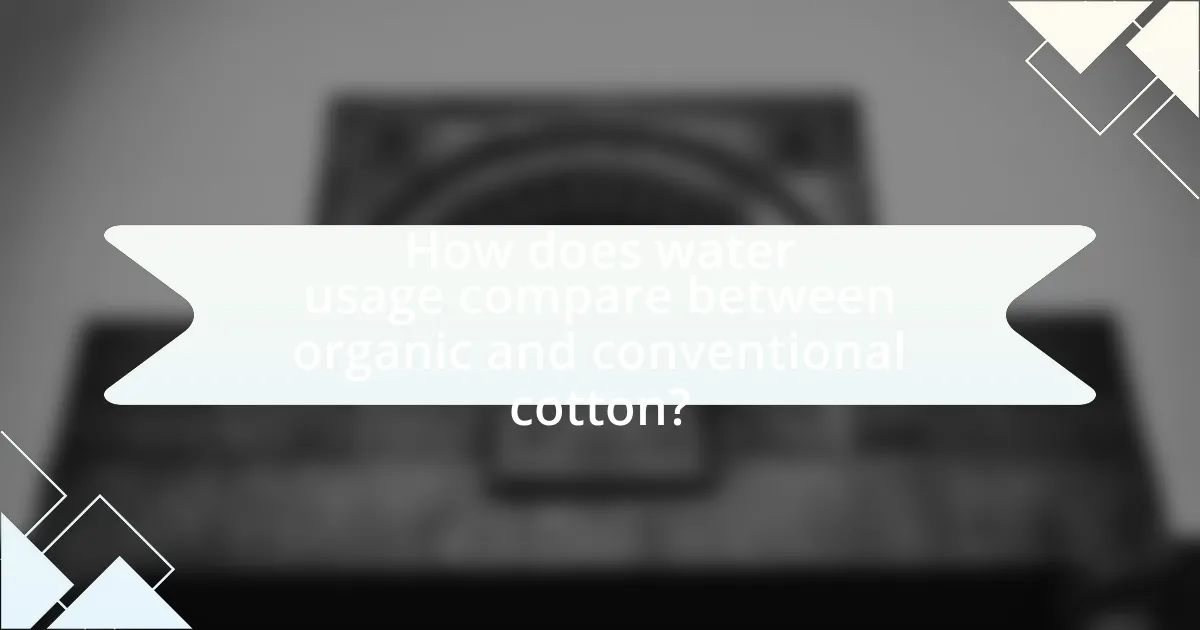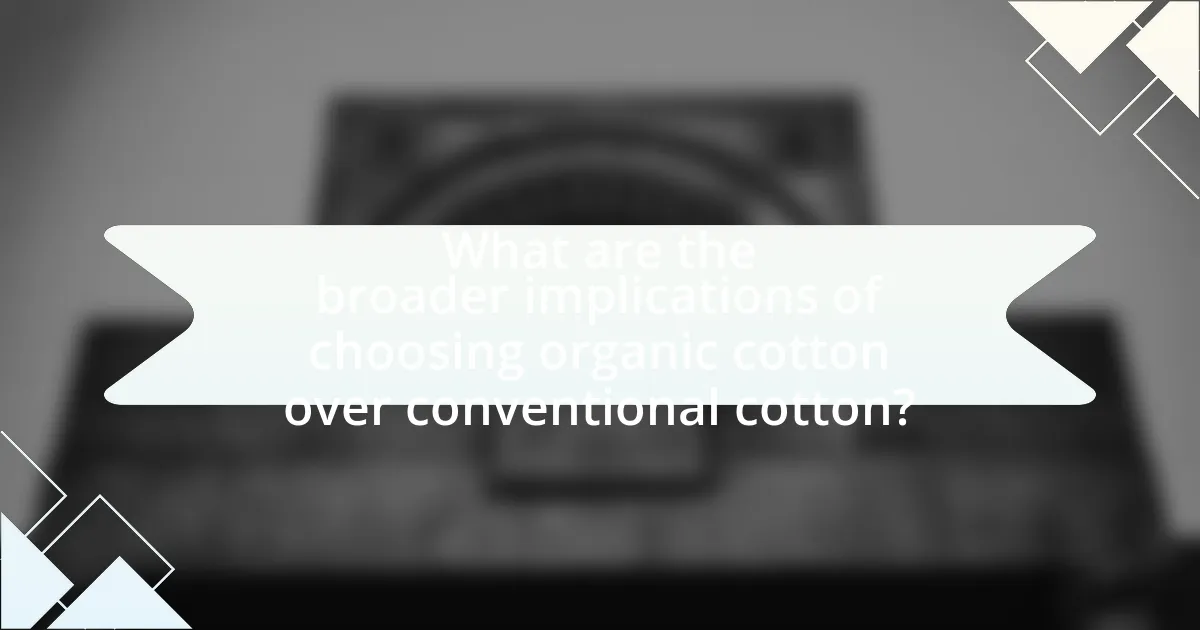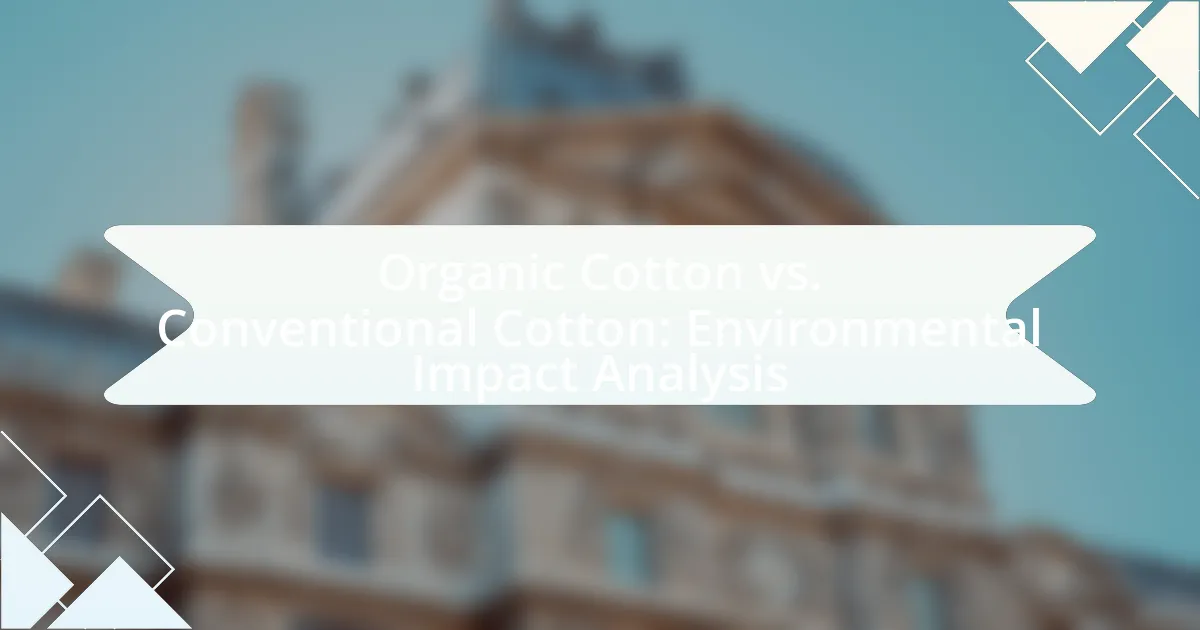The article analyzes the environmental impact of organic cotton compared to conventional cotton, highlighting the significant advantages of organic farming practices. Organic cotton is cultivated without synthetic pesticides and fertilizers, resulting in reduced soil and water contamination, enhanced biodiversity, and lower water usage—up to 91% less than conventional methods. The article discusses key agricultural practices in organic farming, the detrimental effects of conventional cotton on soil health and local ecosystems, and the broader implications of choosing organic cotton for sustainability and human health. Additionally, it emphasizes the role of consumer choices and certifications in promoting sustainable cotton production.

What is the Environmental Impact of Organic Cotton vs. Conventional Cotton?
Organic cotton has a significantly lower environmental impact compared to conventional cotton. Organic cotton is grown without synthetic pesticides and fertilizers, which reduces soil and water contamination. In contrast, conventional cotton farming relies heavily on chemical inputs, contributing to soil degradation and water pollution.
Research indicates that organic cotton farming uses 91% less water than conventional methods, as reported by the Textile Exchange in their 2021 Organic Cotton Market Report. Additionally, organic farming practices enhance biodiversity and promote healthier ecosystems, while conventional cotton farming often leads to monocultures that diminish biodiversity.
Furthermore, organic cotton farming sequesters more carbon in the soil, helping mitigate climate change effects. A study published in the Journal of Cleaner Production found that organic cotton can reduce greenhouse gas emissions by up to 46% compared to conventional cotton. Thus, the environmental benefits of organic cotton are substantial, making it a more sustainable choice.
How do organic and conventional cotton differ in their cultivation practices?
Organic cotton is cultivated without synthetic pesticides and fertilizers, while conventional cotton relies on these chemicals for growth. Organic farming practices emphasize crop rotation, natural pest control, and the use of organic fertilizers, which enhance soil health and biodiversity. In contrast, conventional methods often involve monoculture and chemical inputs that can lead to soil degradation and reduced biodiversity. According to the Global Organic Textile Standard, organic cotton farming must adhere to strict regulations that prohibit harmful chemicals, ensuring a more sustainable approach to agriculture.
What are the key agricultural methods used in organic cotton farming?
The key agricultural methods used in organic cotton farming include crop rotation, cover cropping, and the use of organic fertilizers and pest management techniques. Crop rotation helps maintain soil fertility and disrupts pest cycles, while cover cropping enhances soil structure and prevents erosion. Organic fertilizers, such as compost and manure, provide essential nutrients without synthetic chemicals. Additionally, organic pest management employs natural predators and biopesticides, reducing reliance on harmful pesticides. These methods collectively promote sustainable farming practices and minimize environmental impact, aligning with the principles of organic agriculture.
How does conventional cotton farming impact soil health?
Conventional cotton farming negatively impacts soil health primarily through the use of synthetic fertilizers and pesticides. These chemicals can lead to soil degradation by disrupting microbial communities, reducing organic matter, and causing nutrient imbalances. For instance, a study published in the journal “Agriculture, Ecosystems & Environment” found that continuous use of chemical inputs in conventional cotton farming resulted in a significant decline in soil fertility and structure over time. Additionally, the reliance on monoculture practices in conventional cotton farming further exacerbates soil erosion and diminishes biodiversity, leading to long-term detrimental effects on soil health.
What are the environmental consequences of using pesticides and fertilizers in conventional cotton?
The environmental consequences of using pesticides and fertilizers in conventional cotton include soil degradation, water contamination, and loss of biodiversity. Pesticides can lead to the accumulation of toxic substances in soil and water systems, adversely affecting aquatic life and drinking water quality. For instance, a study published in the journal “Environmental Science & Technology” found that pesticide runoff from cotton fields significantly contributes to the contamination of nearby rivers and lakes. Additionally, fertilizers can cause nutrient runoff, leading to algal blooms that deplete oxygen in water bodies, harming fish populations. The use of these chemicals also disrupts local ecosystems, reducing the diversity of beneficial insects and soil microorganisms essential for healthy agricultural practices.
How do synthetic chemicals affect local ecosystems?
Synthetic chemicals adversely affect local ecosystems by disrupting natural processes and harming biodiversity. These chemicals, commonly used in conventional agriculture, can contaminate soil and water, leading to reduced soil fertility and altered aquatic habitats. For instance, pesticides can kill non-target species, including beneficial insects and aquatic organisms, which are crucial for maintaining ecological balance. Research indicates that runoff from agricultural fields treated with synthetic fertilizers and pesticides can lead to eutrophication in nearby water bodies, resulting in oxygen depletion and fish kills. Studies have shown that areas with high synthetic chemical usage experience a decline in species richness and abundance, demonstrating the detrimental impact on local wildlife and plant communities.
What are the long-term effects of chemical runoff on water sources?
Chemical runoff has significant long-term effects on water sources, primarily leading to contamination and degradation of aquatic ecosystems. This runoff often contains pesticides, fertilizers, and other harmful chemicals that can disrupt water quality, resulting in increased nutrient loading, which promotes harmful algal blooms. These blooms deplete oxygen levels in the water, causing dead zones where aquatic life cannot survive.
Research indicates that chemical runoff can lead to the bioaccumulation of toxins in fish and other organisms, posing risks to human health through the consumption of contaminated seafood. For instance, a study published in the journal Environmental Science & Technology found that agricultural runoff contributed to elevated levels of nitrates and phosphates in nearby water bodies, which directly correlated with declines in fish populations and biodiversity.
Additionally, long-term exposure to contaminated water can affect drinking water supplies, necessitating costly treatment processes to ensure safety for human consumption. The cumulative impact of chemical runoff thus poses a serious threat to both environmental health and public safety.

How does water usage compare between organic and conventional cotton?
Organic cotton uses significantly less water compared to conventional cotton. Studies indicate that organic cotton farming can reduce water usage by approximately 30% to 50% due to practices such as rain-fed irrigation and improved soil health, which enhances water retention. In contrast, conventional cotton often relies on extensive irrigation systems and chemical fertilizers that can deplete water resources. For example, a study published in the journal “Agriculture, Ecosystems & Environment” found that organic cotton systems utilize less water while maintaining comparable yields, demonstrating a more sustainable approach to water management in agriculture.
What are the water consumption rates for organic cotton farming?
Organic cotton farming typically consumes between 5,000 to 7,000 liters of water per kilogram of cotton produced. This water usage is significantly lower than that of conventional cotton farming, which can require up to 29,000 liters per kilogram. The reduced water consumption in organic cotton farming is attributed to practices such as crop rotation, cover cropping, and the use of organic fertilizers, which enhance soil health and moisture retention. Studies indicate that these sustainable practices contribute to a more efficient use of water resources in organic cotton cultivation.
How does organic farming promote water conservation?
Organic farming promotes water conservation by utilizing practices that enhance soil health and structure, which improves water retention. Techniques such as crop rotation, cover cropping, and reduced tillage increase organic matter in the soil, allowing it to hold more moisture. Research indicates that organic farms can retain up to 30% more water in the soil compared to conventional farms, leading to reduced irrigation needs and less water runoff. This efficient use of water resources is crucial in areas facing water scarcity, demonstrating the significant impact of organic farming on sustainable water management.
What challenges does conventional cotton face regarding water usage?
Conventional cotton faces significant challenges regarding water usage, primarily due to its high water consumption and reliance on irrigation. The cultivation of conventional cotton requires approximately 7,000 to 29,000 liters of water per kilogram of cotton produced, depending on the region and farming practices. This extensive water requirement often leads to the depletion of local water resources, particularly in arid and semi-arid regions where water scarcity is already a pressing issue. Furthermore, the use of chemical fertilizers and pesticides in conventional cotton farming can contaminate water sources, exacerbating the environmental impact and affecting water quality.
How does the geographical location influence the environmental impact of cotton farming?
Geographical location significantly influences the environmental impact of cotton farming by determining climate conditions, water availability, and soil quality. For instance, regions with arid climates often require extensive irrigation, leading to water depletion and soil salinization, as seen in parts of Central Asia where cotton farming has caused significant ecological damage. Conversely, areas with adequate rainfall can support more sustainable farming practices, reducing the need for chemical fertilizers and pesticides. Additionally, local biodiversity and ecosystem health can be affected by the choice of cotton farming methods, with organic practices generally having a lower environmental footprint compared to conventional methods that rely on synthetic inputs.
What regions are most affected by conventional cotton farming practices?
The regions most affected by conventional cotton farming practices include Central Asia, particularly Uzbekistan, as well as parts of India, the United States, and West Africa. In Uzbekistan, extensive irrigation for cotton cultivation has led to the depletion of the Aral Sea, significantly impacting local ecosystems and communities. India faces severe pesticide use and water scarcity issues linked to cotton farming, while the U.S. has seen soil degradation and water pollution from agricultural runoff. West Africa experiences similar challenges, with conventional practices contributing to land degradation and adverse health effects from chemical exposure. These regions exemplify the environmental and social consequences of conventional cotton farming.
How does organic cotton farming adapt to different climates?
Organic cotton farming adapts to different climates through the use of diverse cultivation practices tailored to local environmental conditions. For instance, in arid regions, organic cotton farmers implement techniques such as rainwater harvesting and mulching to conserve moisture, while in humid climates, they may focus on crop rotation and intercropping to enhance soil health and reduce pest pressures. Research indicates that organic farming practices can improve soil structure and fertility, which is crucial for maintaining productivity across varying climates. Studies have shown that organic cotton can yield comparable or even superior results in diverse climatic conditions, demonstrating its adaptability and resilience.

What are the broader implications of choosing organic cotton over conventional cotton?
Choosing organic cotton over conventional cotton has significant broader implications for environmental sustainability and human health. Organic cotton farming practices reduce the use of synthetic pesticides and fertilizers, which can contaminate soil and water sources, thereby promoting healthier ecosystems. According to the Textile Exchange, organic cotton farming uses 91% less water compared to conventional methods, which is crucial in water-scarce regions. Additionally, organic cotton supports biodiversity by fostering a habitat for various species, as it avoids harmful chemicals that can disrupt local flora and fauna. Furthermore, the shift to organic cotton can enhance the livelihoods of farmers by providing them with access to premium markets and reducing their exposure to toxic substances, ultimately contributing to better health outcomes for agricultural communities.
How does consumer choice impact the cotton industry and the environment?
Consumer choice significantly impacts the cotton industry and the environment by driving demand for either organic or conventional cotton. When consumers prefer organic cotton, it encourages farmers to adopt sustainable practices that reduce pesticide use and promote biodiversity, leading to less environmental degradation. For instance, organic cotton farming uses 71% less water compared to conventional methods, as reported by the Textile Exchange in their 2021 Organic Cotton Market Report. Conversely, if consumers favor conventional cotton, it perpetuates practices that often involve harmful chemicals and higher water consumption, contributing to soil degradation and water scarcity. Thus, consumer preferences directly influence agricultural practices and environmental outcomes in the cotton industry.
What role do certifications play in promoting organic cotton?
Certifications play a crucial role in promoting organic cotton by providing assurance of compliance with organic farming standards. These certifications, such as the Global Organic Textile Standard (GOTS) and the Organic Content Standard (OCS), verify that cotton is grown without synthetic pesticides and fertilizers, thus ensuring environmental sustainability. According to the Textile Exchange, the presence of these certifications can increase consumer trust and demand, as they signify adherence to rigorous environmental and social criteria. This increased consumer awareness and preference for certified organic products directly contribute to the growth of the organic cotton market, encouraging more farmers to adopt organic practices.
How can consumers make informed decisions about cotton products?
Consumers can make informed decisions about cotton products by researching the differences between organic and conventional cotton, focusing on factors such as environmental impact, pesticide use, and certifications. Organic cotton is grown without synthetic pesticides and fertilizers, which reduces environmental harm and promotes biodiversity. In contrast, conventional cotton farming often relies on chemical inputs that can lead to soil degradation and water pollution. According to the Organic Trade Association, organic cotton farming uses 91% less water and 62% less energy compared to conventional methods. Additionally, consumers should look for certifications like GOTS (Global Organic Textile Standard) to ensure the cotton meets organic standards. This information empowers consumers to choose products that align with their values regarding sustainability and health.
What are the best practices for supporting sustainable cotton production?
The best practices for supporting sustainable cotton production include implementing organic farming techniques, promoting water-efficient irrigation methods, and utilizing integrated pest management. Organic farming techniques reduce chemical inputs, enhancing soil health and biodiversity, which is supported by the fact that organic cotton farming can use up to 90% less water compared to conventional methods. Water-efficient irrigation methods, such as drip irrigation, minimize water waste and ensure that crops receive adequate moisture, which is crucial in regions facing water scarcity. Integrated pest management reduces reliance on synthetic pesticides, promoting ecological balance and protecting beneficial insects. These practices collectively contribute to a more sustainable cotton industry, reducing environmental impact and promoting social responsibility.

Leave a Reply